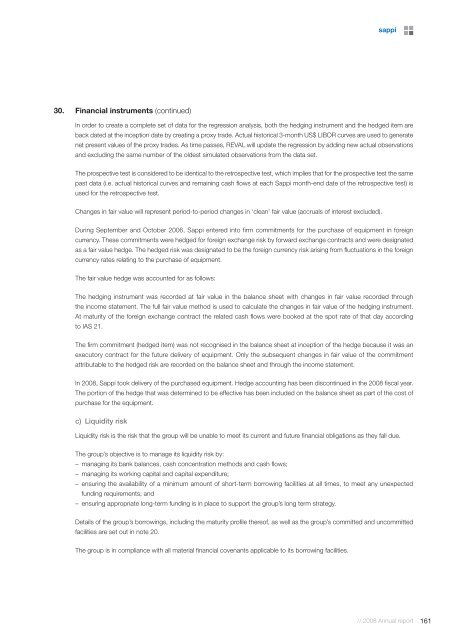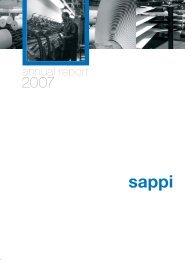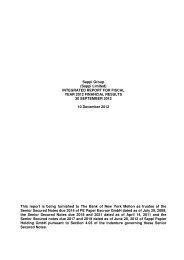2008 Annual report - Sappi
2008 Annual report - Sappi
2008 Annual report - Sappi
You also want an ePaper? Increase the reach of your titles
YUMPU automatically turns print PDFs into web optimized ePapers that Google loves.
sappi //<br />
30. Financial instruments (continued)<br />
In order to create a complete set of data for the regression analysis, both the hedging instrument and the hedged item are<br />
back dated at the inception date by creating a proxy trade. Actual historical 3-month US$ LIBOR curves are used to generate<br />
net present values of the proxy trades. As time passes, REVAL will update the regression by adding new actual observations<br />
and excluding the same number of the oldest simulated observations from the data set.<br />
The prospective test is considered to be identical to the retrospective test, which implies that for the prospective test the same<br />
past data (i.e. actual historical curves and remaining cash flows at each <strong>Sappi</strong> month-end date of the retrospective test) is<br />
used for the retrospective test.<br />
Changes in fair value will represent period-to-period changes in ‘clean’ fair value (accruals of interest excluded).<br />
During September and October 2006, <strong>Sappi</strong> entered into firm commitments for the purchase of equipment in foreign<br />
currency. These commitments were hedged for foreign exchange risk by forward exchange contracts and were designated<br />
as a fair value hedge. The hedged risk was designated to be the foreign currency risk arising from fluctuations in the foreign<br />
currency rates relating to the purchase of equipment.<br />
The fair value hedge was accounted for as follows:<br />
The hedging instrument was recorded at fair value in the balance sheet with changes in fair value recorded through<br />
the income statement. The full fair value method is used to calculate the changes in fair value of the hedging instrument.<br />
At maturity of the foreign exchange contract the related cash flows were booked at the spot rate of that day according<br />
to IAS 21.<br />
The firm commitment (hedged item) was not recognised in the balance sheet at inception of the hedge because it was an<br />
executory contract for the future delivery of equipment. Only the subsequent changes in fair value of the commitment<br />
attributable to the hedged risk are recorded on the balance sheet and through the income statement.<br />
In <strong>2008</strong>, <strong>Sappi</strong> took delivery of the purchased equipment. Hedge accounting has been discontinued in the <strong>2008</strong> fiscal year.<br />
The portion of the hedge that was determined to be effective has been included on the balance sheet as part of the cost of<br />
purchase for the equipment.<br />
c) Liquidity risk<br />
Liquidity risk is the risk that the group will be unable to meet its current and future financial obligations as they fall due.<br />
The group’s objective is to manage its liquidity risk by:<br />
– managing its bank balances, cash concentration methods and cash flows;<br />
– managing its working capital and capital expenditure;<br />
– ensuring the availability of a minimum amount of short-term borrowing facilities at all times, to meet any unexpected<br />
funding requirements; and<br />
– ensuring appropriate long-term funding is in place to support the group’s long term strategy.<br />
Details of the group’s borrowings, including the maturity profile thereof, as well as the group’s committed and uncommitted<br />
facilities are set out in note 20.<br />
The group is in compliance with all material financial covenants applicable to its borrowing facilities.<br />
// <strong>2008</strong> <strong>Annual</strong> <strong>report</strong><br />
161
















